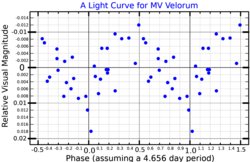 A visual band light curve for MV Velorum, adapted from Sterken et al. (1996) | |
| Observation data Epoch J2000 Equinox J2000 | |
|---|---|
| Constellation | Vela |
| Right ascension | 10 20 54.77319 |
| Declination | −56° 02′ 35.5728″ |
| Apparent magnitude (V) | 4.50 |
| Characteristics | |
| Spectral type | B3 III + A0 IVpSi + A2 + K0 III |
| B−V color index | −0.102±0.014 (A + B) |
| Astrometry | |
| Radial velocity (Rv) | +10.4±2.8 km/s |
| Proper motion (μ) | RA: −7.5 mas/yr Dec.: +4.0 mas/yr |
| Parallax (π) | 2.6564 ± 0.2314 mas |
| Distance | 1,200 ± 100 ly (380 ± 30 pc) |
| Absolute magnitude (MV) | −3.21 (A + B) |
| Details | |
| A (HD 89890) | |
| Radius | 10.07±0.20 R☉ |
| Luminosity | 3,082.41 L☉ |
| Surface gravity (log g) | 3.00±0.03 cgs |
| Temperature | 15,000±150 K |
| Rotational velocity (v sin i) | 26.8±0.5 km/s |
| Other designations | |
| WDS J10209-5603 | |
| A+B: CPD−55 3286, HIP 50676, HR 4074 | |
| A: J Velorum, MV Velorum, HD 89890, SAO 237959, TYC 8604-975-1 | |
| B: SAO 237960, TYC 8604-2444-1 | |
| C: CD−55 3306, SAO 237958, TYC 8604-2137-1 | |
| Database references | |
| SIMBAD | HD 89890 (A) |
| HIC 50676 (A+B) | |
| TYC 8604-2444-1 (B) | |
| CD-55 3306 (C) | |
HD 89890 is the brightest member of a multiple star system with at least four components, located in the southern constellation of Vela. It is visible to the naked eye with an apparent visual magnitude of 4.50. The annual parallax shift of 2.6 mas provides a distance estimate of around 1,200 light-years (370 parsecs). It is moving further away from Earth with a heliocentric radial velocity of +10 km/s.
System
The Washington Double Star Catalog lists three visible components for this system. The brightest, component A, is of visual magnitude 4.50. Component B has a magnitude of 7.179, and as of 2000 lies at an angular separation of 7.10″ from A, along a position angle (PA) of 102°. Component C is a magnitude 9.125 star at a separation of 36.20″ from A at a PA of 191°. The physical link between the stars was described on the basis of their dynamic parallax and mean velocities. The three components A, B and C have Gaia Data Release 2 parallaxes of 2.6564±0.2314 mas, 2.1771±0.0490 mas, and 1.6097±0.0400 mas, respectively.
Properties
Component A has a stellar classification of B3 III, and is categorized as a Be star. It shows photometric variations with multiple periods around 4.6 days and line-profile variations with a period of 2.318 days. The radial velocity of this star is constant. It has 10 times the Sun's radius and shines with 3,082 times the Sun's luminosity from its photosphere at an effective temperature of 15,000 K.
The component B shows a variation in spectra consistent with being a double-lined spectroscopic binary. The brighter member (Ba) is a silicon star with a class of A0 IVpSi, while the fainter component (Bb) is of type A2. Component C has a class of K0 III, indicating it is an evolved giant star. The measured effective temperature of C is 5,500 K. The fact that component A most likely shares a common origin with C suggests that the former is much older than expected, and may actually be a blue straggler formed from the merger of a close binary. This could have been caused by the gravitational influence of an unseen companion of A.
References
- Sterken, C.; Vogt, N.; Mennickent, R. E. (July 1996). "Long-term photometry of Be stars. II. Periodic variations on time scales of days to months". Astronomy and Astrophysics. 311: 579–586. Bibcode:1996A&A...311..579S. Retrieved 30 April 2022.
- ^ Brown, A. G. A.; et al. (Gaia collaboration) (August 2018). "Gaia Data Release 2: Summary of the contents and survey properties". Astronomy & Astrophysics. 616. A1. arXiv:1804.09365. Bibcode:2018A&A...616A...1G. doi:10.1051/0004-6361/201833051. Gaia DR2 record for this source at VizieR.
- ^ Jaschek, M; Egret, D; Jaschek, M; Groth, H. -G (1982). "Catalog of Be stars". Be Stars. 98: 261–263. Bibcode:1982IAUS...98..261J. doi:10.1007/978-94-009-8565-0_44 (inactive 1 November 2024). ISBN 978-90-277-1367-4.
{{cite journal}}: CS1 maint: DOI inactive as of November 2024 (link) - ^ Veramendi, M. E.; González, J. F. (July 2014), "Spectroscopic study of early-type multiple stellar systems. II. New binary subsystems", Astronomy & Astrophysics, 567: 10, arXiv:1405.1084, Bibcode:2014A&A...567A..35V, doi:10.1051/0004-6361/201423736, S2CID 21711755, A35.
- ^ Anderson, E.; Francis, Ch. (2012), "XHIP: An extended hipparcos compilation", Astronomy Letters, 38 (5): 331, arXiv:1108.4971, Bibcode:2012AstL...38..331A, doi:10.1134/S1063773712050015, S2CID 119257644.
- ^ Röser, S.; Bastian, U. (September 1988), "A New Star Catalogue of SAO Type", Astronomy and Astrophysics Supplement Series, 74: 449, Bibcode:1988A&AS...74..449R.
- ^ Arcos, C.; et al. (March 2018), "Stellar parameters and H α line profile variability of Be stars in the BeSOS survey", Monthly Notices of the Royal Astronomical Society, 474 (4): 5287–5299, arXiv:1711.08675, Bibcode:2018MNRAS.474.5287A, doi:10.1093/mnras/stx3075, S2CID 74872624.
- ^ "HD 89890". SIMBAD. Centre de données astronomiques de Strasbourg. Retrieved 2018-08-08.
- ^ Høg, E.; et al. (March 2000). "The Tycho-2 catalogue of the 2.5 million brightest stars". Astronomy and Astrophysics. 355: L27 – L30. Bibcode:2000A&A...355L..27H. doi:10.1888/0333750888/2862. ISBN 978-0333750889.
- Mason, B. D.; et al. (2014), "The Washington Visual Double Star Catalog", The Astronomical Journal, 122 (6): 3466–3471, Bibcode:2001AJ....122.3466M, doi:10.1086/323920.
| Constellation of Vela | |||||||||||
|---|---|---|---|---|---|---|---|---|---|---|---|
| Stars |
| ||||||||||
| |||||||||||
| Star clusters |
| ||||||||||
| Nebulae |
| ||||||||||
| Galaxies |
| ||||||||||
| |||||||||||